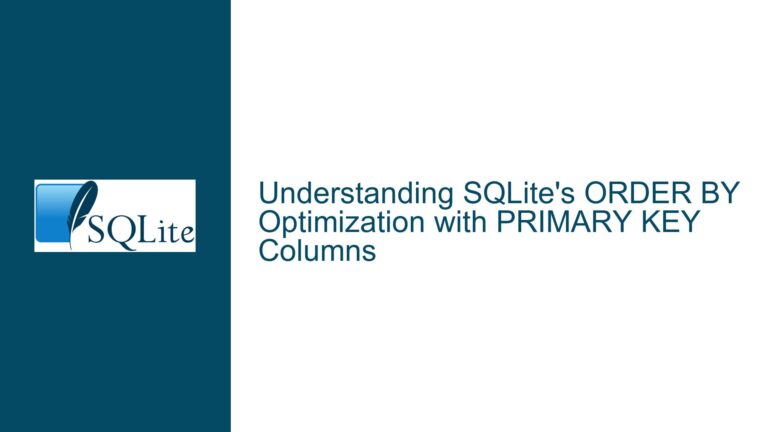SQLite’s Preference for SCAN TABLE Over SEARCH TABLE in Index Selection
SQLite Query Planner’s Index Selection Behavior
SQLite’s query planner is designed to optimize query execution by selecting the most efficient index for a given query. However, there are scenarios where the query planner may prefer a SCAN TABLE USING INDEX over a SEARCH TABLE USING INDEX, which can be counterintuitive at first glance. This behavior is influenced by several factors, including the distribution of data within the table, the structure of the query, and the specific indexes available.
In the context of the provided schema and queries, the table trk_config_records has two indexes: trk_cfg_idx_expires on the expires column and trk_cfg_idx_niid_mod on the niid and modulename columns. The query in question involves a SELECT statement with a WHERE clause that filters on the expires column and an ORDER BY clause that sorts on the niid and modulename columns. The query planner’s decision to use the trk_cfg_idx_niid_mod index for a SCAN TABLE operation instead of the trk_cfg_idx_expires index for a SEARCH TABLE operation is influenced by the following considerations:
Data Distribution: If a significant portion of the rows in the table match the
WHEREclause condition, using theexpiresindex would result in a linear scan of the index, followed by a sort operation. In such cases, scanning theniid-modulenameindex directly may be more efficient, as it avoids the additional sort step.Index Structure: The
trk_cfg_idx_niid_modindex is structured to support theORDER BYclause directly. If the query planner determines that the cost of scanning this index and filtering the results in memory is lower than the cost of using theexpiresindex and then sorting the results, it will opt for the former.Query Complexity: The presence of an
ORcondition in theWHEREclause (expires = 0 OR expires > strftime('%s','now')) complicates the query planner’s decision-making process. The query planner must evaluate whether theexpiresindex can effectively handle theORcondition or if it is more efficient to scan theniid-modulenameindex and filter the results in memory.
Factors Influencing SQLite’s Index Selection
The decision to use one index over another is not arbitrary but is based on a cost-based analysis performed by the SQLite query planner. The following factors play a crucial role in this decision-making process:
Selectivity of the Index: The selectivity of an index refers to the number of distinct values in the index relative to the total number of rows in the table. An index with high selectivity (i.e., many distinct values) is more likely to be used for a
SEARCH TABLEoperation, as it can quickly narrow down the rows that match the query conditions. Conversely, an index with low selectivity may result in aSCAN TABLEoperation, as the query planner determines that scanning the index and filtering the results in memory is more efficient.Query Conditions: The nature of the conditions in the
WHEREclause can influence the query planner’s decision. For example, a simple equality condition (expires = 0) is more likely to benefit from an index on theexpirescolumn, whereas a range condition (expires > strftime('%s','now')) may require a more complex evaluation. The presence of anORcondition further complicates the query planner’s task, as it must consider the combined selectivity of the conditions.Sorting Requirements: The
ORDER BYclause in a query can also influence the choice of index. If an index exists that matches the sorting order specified in theORDER BYclause, the query planner may prefer to use that index, even if it results in aSCAN TABLEoperation. This is because the index can provide the sorted results directly, eliminating the need for an additional sort step.Table Size and Data Distribution: The size of the table and the distribution of data within it can significantly impact the query planner’s decision. In a large table with a skewed distribution of data, the query planner may determine that scanning an index and filtering the results in memory is more efficient than using a less selective index for a
SEARCH TABLEoperation.
Optimizing SQLite Queries for Index Usage
To ensure that SQLite uses the most appropriate index for a given query, developers can take several steps to guide the query planner’s decision-making process. These steps include:
Analyzing Query Plans: The
EXPLAIN QUERY PLANstatement is a powerful tool for understanding how SQLite plans to execute a query. By analyzing the output of this statement, developers can gain insights into the query planner’s decision-making process and identify potential inefficiencies.Using Index Hints: SQLite allows developers to provide hints to the query planner using the
INDEXED BYclause. This clause can be used to force the query planner to use a specific index, even if it would not normally choose to do so. However, this approach should be used with caution, as it can lead to suboptimal query plans if the chosen index is not appropriate for the query.Optimizing Indexes: The design of indexes can have a significant impact on query performance. Developers should ensure that indexes are designed to support the most common query patterns. For example, if a query frequently filters on a specific column and sorts on another, a composite index on both columns may be more effective than separate indexes on each column.
Simplifying Query Conditions: Complex query conditions, such as those involving
ORoperators, can complicate the query planner’s task. Simplifying these conditions, either by restructuring the query or by normalizing the data, can help the query planner make better decisions.Considering Data Distribution: Understanding the distribution of data within the table can help developers make informed decisions about index design and query optimization. For example, if a column contains a large number of duplicate values, an index on that column may not be very selective, and the query planner may prefer to scan the table instead.
In the specific case of the trk_config_records table, the query planner’s decision to use the trk_cfg_idx_niid_mod index for a SCAN TABLE operation can be influenced by the data distribution and the complexity of the query conditions. By analyzing the query plan and considering the factors discussed above, developers can make informed decisions about how to optimize their queries and indexes for better performance.
Implementing PRAGMA journal_mode and Database Backup Strategies
In addition to optimizing queries and indexes, developers should also consider the broader context of database performance and reliability. SQLite provides several mechanisms for improving database performance and ensuring data integrity, including the use of PRAGMA statements and robust backup strategies.
PRAGMA journal_mode: The
PRAGMA journal_modestatement controls how SQLite handles the journal file, which is used to ensure atomic transactions. Different journal modes offer varying trade-offs between performance and reliability. For example, theWAL(Write-Ahead Logging) mode can significantly improve write performance by allowing concurrent reads and writes, while theDELETEmode provides a more traditional approach to transaction management.Database Backup: Regular backups are essential for protecting against data loss. SQLite provides several methods for backing up databases, including the
.backupcommand in the SQLite command-line interface and thesqlite3_backup_initAPI function. Developers should establish a regular backup schedule and test their backup procedures to ensure that they can recover data in the event of a failure.
By combining these strategies with careful query and index optimization, developers can ensure that their SQLite databases perform efficiently and reliably, even under demanding conditions.






